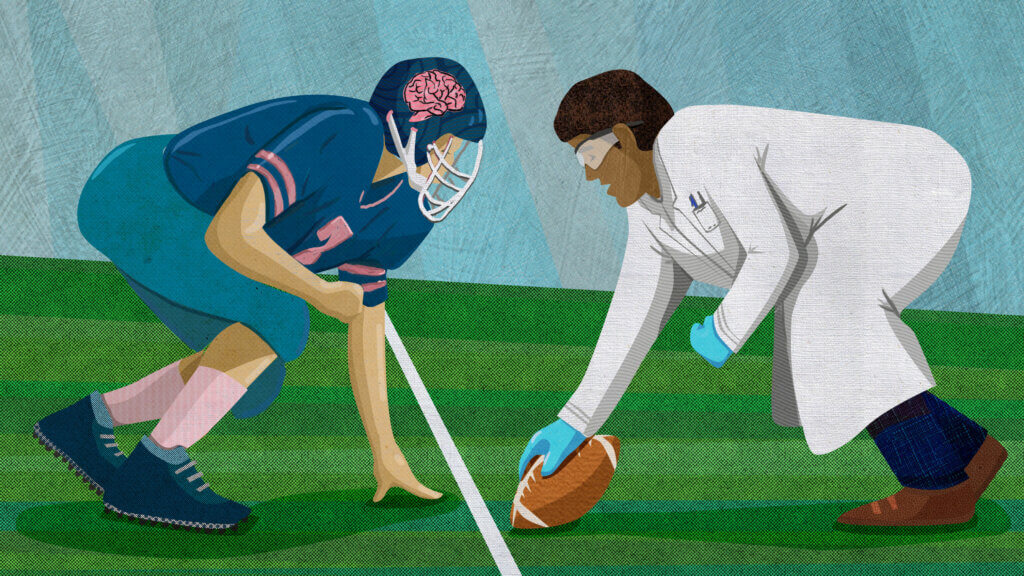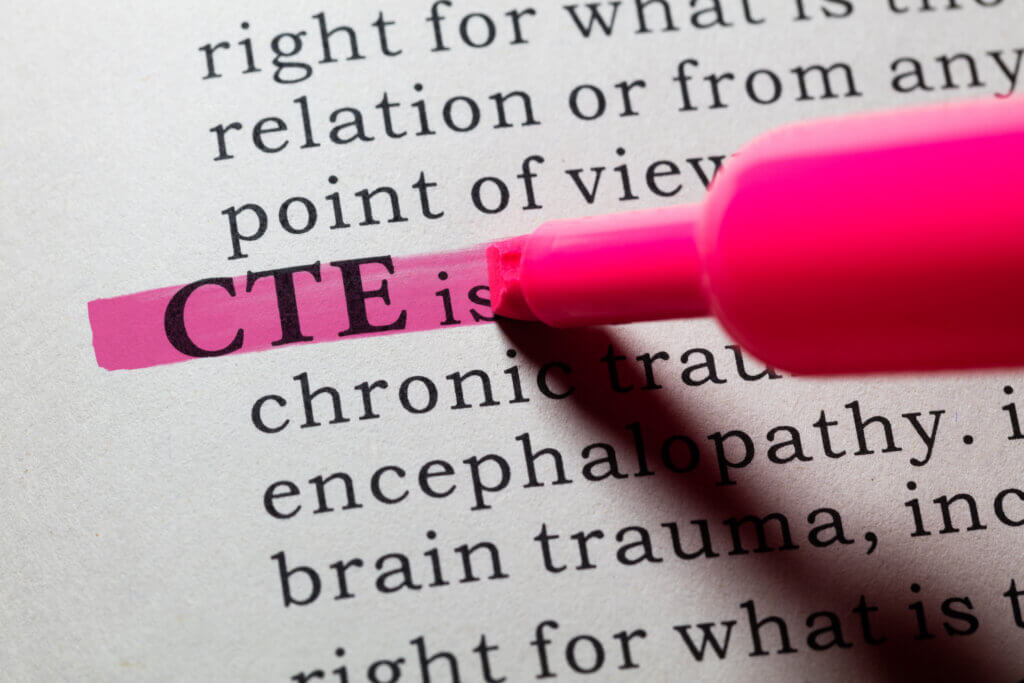For years, researchers have known that athletes who endure repeated blows to the head in high-contact sports like football and soccer may develop a devastating brain disease called chronic traumatic encephalopathy, or CTE. But diagnosing CTE in the living has remained an elusive goal, hampering efforts to understand this puzzling condition. Now, new research from Boston University’s CTE Center brings doctors one step closer to spotting the disease before death.
The study, published in the journal Molecular Neurodegeneration, reveals a direct relationship between the amount of CTE-related brain pathology and the severity of cognitive and behavioral symptoms in patients’ lives.
“For the first time, we were able to show a clear dose-response relationship between the amount of CTE pathology and the severity of cognitive and functional symptoms, including problems with memory and executive function,” says Dr. Jesse Mez, a CTE Center co-director and an associate professor of neurology at BU’s medical school, in a statement.
CTE results from a buildup of toxic tau protein in the brain, brought on by repeated head impacts. The protein forms clumps that slowly spread, killing healthy neurons. This process leads to problems with memory, decision-making, impulse control and other functions. But because CTE can only be diagnosed after death, connecting symptoms in the living to the actual brain changes has remained extremely difficult.
Measuring Tau Buildup
To explore the tau-symptom link, Mez and colleagues examined donated brain tissue from 364 deceased male athletes diagnosed after death with CTE. Of these, 333 were former football players and the rest played other contact sports. The researchers used laboratory techniques to measure levels of p-tau protein in 10 key regions of each athlete’s brain, including areas involved in memory, reasoning, emotion, and movement control.
Players’ family members and friends also filled out standard questionnaires before death detailing concerns about each athlete’s thinking abilities, behavior regulation, depression, and ability to function independently in daily life.
Higher p-tau levels were found in brain areas closest to where blows to the head tend to land, like the frontal cortex behind the forehead. When p-tau levels were highest overall across all 10 brain regions, athletes were reported before death to have more problems with thinking skills like attention, planning, and memory. More frontal lobe tau was also linked to certain behavioral changes like poor impulse control and judgment.
They also needed more help from others in daily activities like using the phone, taking medications properly, and handling bills and finances.

“Higher levels of this toxic protein in areas involved in learning, memory, decision-making, and emotional regulation were associated with more pronounced difficulties in these areas during life,” explains Dr. Michael Alosco, a study co-author and CTE Center codirector.
Altogether, p-tau levels explained 13% to 49% of the extent of problems reported with thinking and daily function among the athletes. More modest connections were seen between p-tau and symptoms like depression and apathy.
The findings validate proposed research criteria for diagnosing CTE in the living, Alosco says. These criteria, developed by the National Institute of Neurological Disorders and Stroke, flag symptoms including memory loss, executive dysfunction and impulsivity as potential red flags for CTE.
The researchers did note some limitations, including lack of brain donations from female athletes and non-contact sport athletes to serve as comparison groups. The donated brains also came mostly from families who had observed symptoms while the athletes were still alive, so they may not represent the full spectrum of long-term outcomes.
Hope for the Living
While the analysis relied on secondhand symptom reports from family members, Alosco says it still marks key advances. “This can offer valuable information, but we need to move toward a model where we objectively assess individuals during life and follow them until brain donation,” he notes.
Mez agrees, saying he hopes the research will pave the way for definitive CTE diagnoses in patients who are still alive. This could open doors to better treatments and clinical trials of potential therapies.
“With validated in-life diagnostic criteria, we will be able to design clinical trials for therapies,” Mez says. “These findings provide a clear step forward toward diagnosing CTE in life. Diagnosis is crucial before we can test therapies.”
Overall, the study supports assessing p-tau levels in specific brain areas via imaging scans as a biomarker to improve diagnosis and measure the effectiveness of investigational drugs to treat CTE in living patients. Based on p-tau’s links to particular clinical features in different brain regions found in this study with deceased athletes, clinicians may be able to predict better what symptoms patients are likely to experience as CTE progresses.
Understanding Risks
Experts say the research also highlights the risks facing contact sport athletes and others who experience frequent head impacts.
“We know from many studies that the repeated blows these athletes take add up, causing progressive brain damage over time,” explains Dr. Ann McKee, a neuropathologist who runs BU’s brain bank. “The more years playing and the more hits, the more likely CTE will develop and worsen.”
While contact sports remain popular, McKee says athletes and families should go in with eyes wide open about potential consequences. “Head protection helps, but no helmet can fully prevent the tissue damage from high-force collisions,” she stresses.
For now, early detection offers a lifeline to those already experiencing effects of years of cranial pummeling on the field or rink. By linking specific symptom profiles to underlying brain changes, researchers hope to provide answers that allay fears and open doors to support.
“So many former players struggling with memory gaps, emotional issues, motor problems and pain don’t know where to turn or what’s causing their decline,” Mez says. “Validating the pathology behind their symptoms will reduce that uncertainty, offering some reassurance and a roadmap for management.”
With further research, he adds, “We hope to not only diagnose CTE earlier but also track disease progression and target treatments. This gets us one step closer.”












